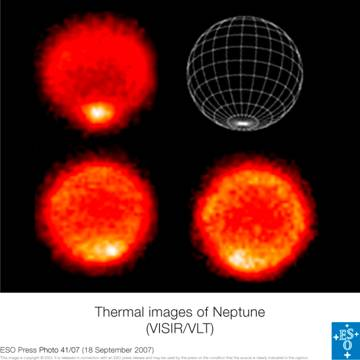25 September 2007

An international team of astronomers using the Very Large Telescope (VLT) of the European Southern Observatory (ESO) has discovered that the south pole of Neptune is the hottest region of the planet. This is consistent with the fact that it is late southern summer in Neptune, and this region has been in sunlight for about 40 years.
The scientists are revealing the first temperature maps of the lowest layers of the Neptunian atmosphere, showing that this warm south pole is providing an avenue for methane to leak out of the deep atmosphere.
"The temperatures are so high that methane gas, which should be frozen out in the upper part of Neptune's atmosphere (the stratosphere), can leak out through this region," said Glenn Orton, lead author of the study. "This solves a long-standing problem of identifying the source of Neptune's high stratospheric methane abundances."
The temperature at the south pole is higher than anywhere else on the planet by about 10° C. The average temperature on Neptune is about -200° C.
Neptune is the farthest planet from the Sun. Its average distance from the Sun is approximately 30 times that of Earth (approximately 150 million km). Neptune receives only about 1/900th as much sunlight as Earth. However, Neptune's atmosphere is significantly affected by this feeble sunlight.
The researchers concluded that these temperature variations are consistent with seasonal changes. As Neptune orbits the Sun every 165 years approximately, a Neptunian season lasts about 40 years. It has been summer in the south pole of Neptune for about 40 years now, and the team predicts that as winter turns to summer in the north pole, an abundance of methane will leak out of a warm north pole in about 80 years.
"Neptune's south pole is currently tilted toward the Sun, just like the Earth's south pole is tilted toward the Sun during summer in the Southern Hemisphere," explains Orton. "On Neptune the Antarctic summer lasts 40 years instead of a few months, and a lot of solar energy input during that time can make big temperature differences between the regions in continual sunlight and those with day-night variations."
"Neptune has the strongest winds of any planet in the Solar System. Sometimes, the wind blows there at more than 2000 kilometres per hour. It is certainly not the place you would like to go on a holiday," Orton added.
Neptune is characterized by its blue color. Although methane is not a major constituent of Neptune's atmosphere, it is the methane in Neptune's upper atmosphere that absorbs the red light from the Sun and reflects the blue light back into space, rendering the planet its distinctive blue color. Like the other giant Jovian planets of the Solar System, Neptune is composed primarily of hydrogen and helium.
Further Reading
ESO's Press Release
http://www.eso.org/public/outreach/press-rel/pr-2007/pr-41-07.html
VLT
http://www.eso.org/public/astronomy/teles-instr/paranal.html
Aymen Mohamed Ibrahem
Senior Astronomy Specialist